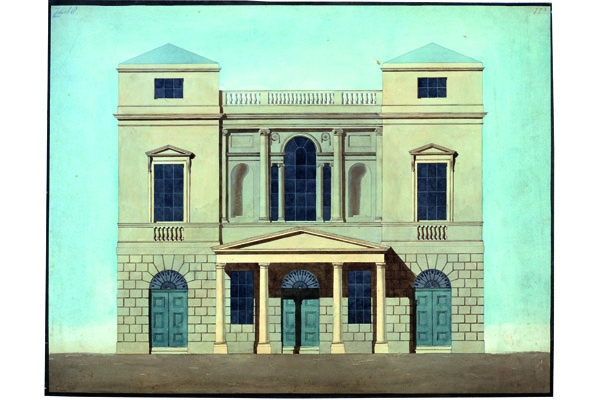James Wyatt was considered by George III to be ‘the first architect of the kingdom’, but he was also the unluckiest, or perhaps most careless, architect of his day. Fonthill Abbey, the Gothic extravaganza he designed for William Beckford, collapsed after just 25 years. He started building a new palace for the king at Kew, which was later blown up by George IV. His Tudor-Gothic remodelling of the Palace of Westminster went massively over budget, was deeply unpopular and employed a combination of timber and plaster that proved spectacularly flammable in 1834. And the commission that made Wyatt’s name, the assembly rooms of the Oxford Street Pantheon, was only 20 years old when it was devastated by fire. The little that remained was torn down in 1937 to make way for Marks & Spencer.
To achieve immortal fame, architects first have to hope their buildings stay standing; but Wyatt also failed to meet the aesthetic criteria of later critics. His irreverent — even gung-ho — approach to cathedral ‘improvement’ earned him the epithet ‘The Destroyer’ among the new antiquarian-preservationist lobby. And his austere take on neoclassical style was later seen as too severe, his country houses out of keeping with their surroundings. The architect C.R. Cockerell described Bryanston in Dorset as ‘a house built for a city’, with ‘the lower part looking like a prison’:
There is a cold and old stateliness which appals and awes me. Instead of having its roots and wings attaching it to the ground, it rises like a great box dropt upon the ground.
As early as 1778, the heroine of Fanny Burney’s novel Evelina decided the Pantheon was a place that ‘rather inspires awe and solemnity than mirth and pleasure’.
However, while the exteriors of Wyatt’s Palladian villas were designed to be imposing, signalling their owners’ wealth and social status, the true scope of his abilities was revealed inside. John Martin Robinson’s sumptuous and scholarly study, based on decades of painstaking research and beautifully produced by the Mellon Centre for Studies in British Art at Yale, is the perfect guide to Wyatt’s achievement.
Robinson explains how, during his first, neoclassical phase, Wyatt designed every last detail of interior decoration and furniture. He was not an architect in the restricted, modern sense, but obsessively sketched everything from colleges and mausoleums to soup tureens, dining chairs and teapots. His career was the combination of a Grand Tour education and a background in the Staffordshire of the Industrial Revolution, and he developed a neoclassical style that could be manufactured using new techniques and materials. Robinson shows how Wyatt pioneered the use of industrial methods to fill the Georgian country house, and claims him as the ‘most prolific designer of furniture among English architects’, with the possible exception only of Pugin.
Wyatt was unable to turn down a commission, but equally unable to cope with multiple projects, leading to long delays and furious clients. He was also useless at managing his finances and so, despite a vast practice, royal patronage, public offices and a subscription from at least three members of the nobility to stop him travelling to Russia to work for Catherine the Great, he died intestate. Robinson refers to his ‘cloud-flecked years after 1800’, which he seems to have spent mostly drunk. By the time of his death in a carriage accident in 1813, his mismanagement had almost single-handedly closed down the Office of Works, and his widow Rachel had to be bailed out of a debtors’ prison. However, the government paid for a lavish funeral and Wyatt was buried in Westminster Abbey.
The destruction of so much of Wyatt’s output presents considerable problems, and the loss of important archives of letters and drawings makes attribution extremely difficult. Given these challenges, Robinson’s study is a truly extraordinary achievement. Every attribution is carefully weighed, every aspect of Wyatt’s style described, and his career is generously illustrated with more than 300 plates. Fine examples of Wyatt’s art still survive — for example, at Castle Coole, outside Enniskillen, the Radcliffe Observatory in Oxford, and Ashridge in Hertfordshire — and Robinson has written the definitive account of his career.





Comments